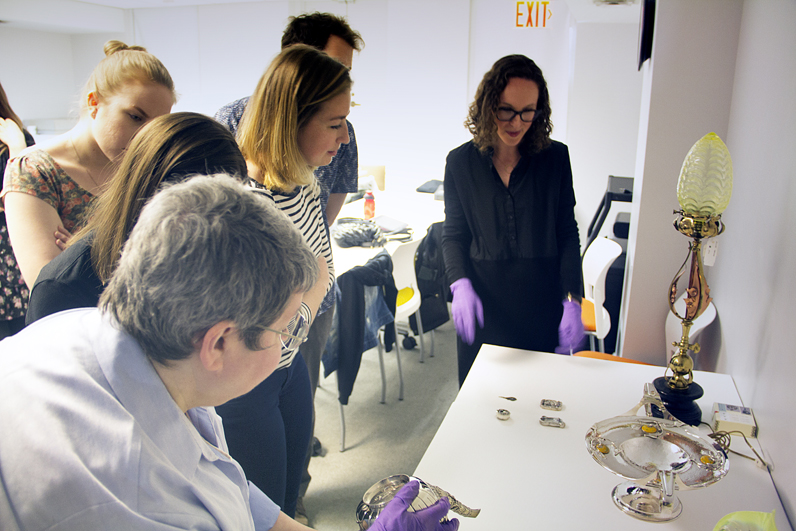
In Parsons’ History of Design and Curatorial Studies Program, the Museum is the Classroom
In the third-floor curatorial department of Cooper Hewitt, Smithsonian Design Museum is a collection of objects that illuminate a bygone era of design: A W.A.S. Benson glass table lamp, a silver Lalique stick pin, and a Tiffany vase with fern frond designs that caught Lauren Sciarappa’s eye.
“It’s something I’d probably never see in my life outside of this room,” she says of the vase, a striking example of Art Nouveau. “The objects carry the time they’re from into the future with them. It’s evidence that this time existed.”
Normally, the objects are viewable only behind glass. But in this classroom, the objects—history itself—can be experienced firsthand.
The museum is the setting for Parsons School of Design and Cooper Hewitt’s History of Design and Curatorial Studies MA (HDCS), a program in which students work directly with the collections and staff at Cooper Hewitt, New York City’s world-renowned design museum. Unlike other programs of its kind, HDCS gives students a rare up-close view of objects that the general public can only observe on slides, in history books, and in glass cases.
“Working directly with objects allows students to make connections that simply are not possible with books and slides,” says HDCS program director Sarah A. Lichtman. “How things feel, what they weigh, their texture—these things can be learned only through hands-on experience.”
On a spring afternoon this past semester, students studied Art Nouveau, a late-19th- and early 20th-century style that depicts features of the natural world. It was one thing to see pictures of the objects on the projector, but entirely different to see them in person.
“I tell people we are studying history with props,” says Tanya Piacentina, HDCS MA ’16. “It’s phenomenal to have the opportunity to interact with the object. It takes the learning experience to the next level, and you can’t get that in a lot of programs.”
Also unique is the opportunity to pursue curatorial studies in an actual museum—and a world-class one at that. Cooper Hewitt, which has housed the HDCS (formerly named History of Decorative Arts and Design) for more than 30 years, was recently reopened after a three-year, $91 million renovation, giving students the chance to work directly with the museum’s collections and staff.
Students who graduate from HDCS will be at an advantage as they enter the workforce.
“Our students go into the world armed with the practical skills and theoretical foundation they need to enter fields of practice in commercial, nonprofit, and academic settings,” Lichtman says. “Together Parsons and Cooper Hewitt have helped design culture thrive for more than 30 years by training the professionals who are leading organizations and institutions around the world.”
For the students in HDCS, it’s hard to imagine learning about museum collections and curation in a traditional classroom setting. Sciarappa, HDCS ’16, cherishes the opportunity to be inside Cooper Hewitt and experience its celebrated collections of art and design.
“People lived with these objects genuinely,” she said. “In some ways, we still can live with them.”